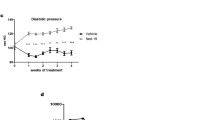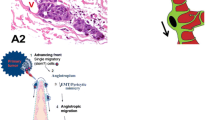Abstract
Because the progression and metastasis of solid tumors depend on their local microcirculation, we sought to characterize tumor angiogenesis three dimensionally in a highly metastatic mouse melanoma model, B16BL6 (B16), injected with Matrigel into the subcutis in the skin on the back of syngeneic C57BL/6 mice. We found that B16 with Matrigel grew significantly faster than B16 alone and had altered tumor angiogenesis. Tumor vessels apparently grew vigorously in the opposite direction of the tumor without invading the tumor mass until at least day 10 of injection. In addition, vascular branching resulted not only from sprouting as was seen in B16 without Matrigel but also from vascular splitting, either because of compression from outside the vessels or from septum formation by endothelial cells. This phenomenon was characteristic of B16 cells, but not of other tumor cells, including Lewis lung carcinoma and ASH-1 hybridoma cell lines, both of which were tested under the same conditions. The reduction in various angiogenic factors in Matrigel did not affect the angiogenic patterns and tumor growth. We hypothesize that tumor vessels may vigorously alter their angiogenic patterns in response to the local microenvironment.
Similar content being viewed by others
References
Folkman J (1971) Tumor angiogenesis: therapeutic implications. N Engl J Med 285:1182–1186
Folkman J, Shing Y (1992) Angiogenesis. J Biol Chem 267:10931–10934
Hillen F, Griffioen AW (2007) Tumour vascularization: sprouting angiogenesis and beyond. Cancer Metastasis Rev 26:489–502
McDonald DM, Baluk P (2005) Imaging of angiogenesis in inflamed airways and tumors: newly formed blood vessels are not alike and may be wildly abnormal: Parker B. Francis lecture. Chest 128:602S–608S
Morikawa S, Baluk P, Kaidoh T, Haskell A, Jain RK, McDonald DM (2002) Abnormalities in pericytes on blood vessels and endothelial sprouts in tumors. Am J Pathol 160:985–1000
Kalluri R (2003) Basement membranes: structure, assembly and role in tumour angiogenesis. Nat Rev Cancer 3:422–433
Baluk P, Morikawa S, Haskell A, Mancuso M, McDonald DM (2003) Abnormalities of basement membrane on blood vessels and endothelial sprouts in tumors. Am J Pathol 163:1801–1815
Dome B, Hendrix MJ, Paku S, Tovari J, Timar J (2007) Alternative vascularization mechanisms in cancer: pathology and therapeutic implications. Am J Pathol 170:1–15
Holash J, Maisonpierre PC, Compton D, Boland P, Alexander CR, Zagzag D, Yancopoulos GD, Wiegand SJ (1999) Vessel cooption, regression, and growth in tumors mediated by angiopoietins and VEGF. Science 284:1994–1998
Dome B, Paku S, Somlai B, Timar J (2002) Vascularization of cutaneous melanoma involves vessel co-option and has clinical significance. J Pathol 197:355–362
Kurz H, Burri PH, Djonov VG (2003) Angiogenesis and vascular remodeling by intussusception: from form to function. News Physiol Sci 18:65–70
Burri PH, Djonov V (2002) Intussusceptive angiogenesis: the alternative to capillary sprouting. Mol Aspects Med 23:S1–S27
Asahara T, Kawamoto A (2004) Endothelial progenitor cells for postnatal vasculogenesis. Am J Physiol Cell Physiol 287: C572–C579
Kaidoh T, Yasugi T, Uehara Y (1991) The microvasculature of the 7,12-dimethylbenz(a)anthracene (DMBA)-induced rat mammary tumour. I. Vascular patterns as visualized by scanning electron microscopy of corrosion casts. Virchows Arch A Pathol Anat Histopathol 418:111–117
Brat DJ, Van Meir EG (2001) Glomeruloid microvascular proliferation orchestrated by VPF/VEGF: a new world of angiogenesis research. Am J Pathol 158:789–796
Hendrix MJ, Seftor EA, Hess AR, Seftor RE (2003) Vasculogenic mimicry and tumour-cell plasticity: lessons from melanoma. Nat Rev Cancer 3:411–421
Maniotis AJ, Folberg R, Hess A, Seftor EA, Gardner LM, Pe’er J, Trent JM, Meltzer PS, Hendrix MJ (1999) Vascular channel formation by human melanoma cells in vivo and in vitro: vasculogenic mimicry. Am J Pathol 155:739–752
Jain RK (2005) Normalization of tumor vasculature: an emerging concept in antiangiogenic therapy. Science 307:58–62
Kleinman HK, McGarvey ML, Liotta LA, Robey PG, Tryggvason K, Martin GR (1982) Isolation and characterization of type IV procollagen, laminin, and heparan sulfate proteoglycan from the EHS sarcoma. Biochemistry 21:6188–6193
Thurston G, Baluk P, Hirata A, McDonald DM (1996) Permeability-related changes revealed at endothelial cell borders in inflamed venules by lectin binding. Am J Physiol 271:H2547–H2562
Fidler IJ (1973) Selection of successive tumour lines for metastasis. Nat New Biol 242:148–149
Ezaki T, Marbrook J (1985) The use of hybridoma cells as a murine model to study tumor immunity. Int J Cancer 35:107–111
Baker JH, Huxham LA, Kyle AH, Lam KK, Minchinton AI (2006) Vascular-specific quantification in an in vivo Matrigel chamber angiogenesis assay. Microvasc Res 71:69–75
Nicosia RF, Ottinetti A (1990) Growth of microvessels in serumfree matrix culture of rat aorta. A quantitative assay of angiogenesis in vitro. Lab Invest 63:115–122
Peyruchaud O, Serre CM, NicAmhlaoibh R, Fournier P, Clezardin P (2003) Angiostatin inhibits bone metastasis formation in nude mice through a direct anti-osteoclastic activity. J Biol Chem 278:45826–45832
Ezaki T, Baluk P, Thurston G, La Barbara A, Woo C, McDonald DM (2001) Time course of endothelial cell proliferation and microvascular remodeling in chronic inflammation. Am J Pathol 158:2043–2055
Kumar P, Wang JM, Bernabeu C (1996) CD 105 and angiogenesis. J Pathol 178:363–366
Kyzas PA, Agnantis NJ, Stefanou D (2006) Endoglin (CD105) as a prognostic factor in head and neck squamous cell carcinoma. Virchows Arch 448:768–775
Amin DN, Hida K, Bielenberg DR, Klagsbrun M (2006) Tumor endothelial cells express epidermal growth factor receptor (EGFR) but not ErbB3 and are responsive to EGF and to EGFR kinase inhibitors. Cancer Res 66:2173–2180
St. Croix B, Rago C, Velculescu V, Traverso G, Romans KE, Montgomery E, Lal A, Riggins GJ, Lengauer C, Vogelstein B, Kinzler KW (2000) Genes expressed in human tumor endothelium. Science 289:1197–1202
Hida K, Hida Y, Amin DN, Flint AF, Panigrahy D, Morton CC, Klagsbrun M (2004) Tumor-associated endothelial cells with cytogenetic abnormalities. Cancer Res 64:8249–8255
Hashizume H, Baluk P, Morikawa S, McLean JW, Thurston G, Roberge S, Jain RK, McDonald DM (2000) Openings between defective endothelial cells explain tumor vessel leakiness. Am J Pathol 156:1363–1380
Miyagami M, Katayama Y (2005) Angiogenesis of glioma: evaluation of ultrastructural characteristics of microvessels and tubular bodies (Weibel-Palade) in endothelial cells and immunohistochemical findings with VEGF and p53 protein. Med Mol Morphol 38:36–42
Auguste P, Lemiere S, Larrieu-Lahargue F, Bikfalvi A (2005) Molecular mechanisms of tumor vascularization. Crit Rev Oncol Hematol 54:53–61
Mundel TM, Kalluri R (2007) Type IV collagen-derived angiogenesis inhibitors. Microvasc Res 74(2–3):85–89
Colorado PC, Torre A, Kamphaus G, Maeshima Y, Hopfer H, Takahashi K, Volk R, Zamborsky ED, Herman S, Sarkar PK, Ericksen MB, Dhanabal M, Simons M, Post M, Kufe DW, Weichselbaum RR, Sukhatme VP, Kalluri R (2000) Antiangiogenic cues from vascular basement membrane collagen. Cancer Res 60:2520–2526
Maeshima Y, Manfredi M, Reimer C, Holthaus KA, Hopfer H, Chandamuri BR, Kharbanda S, Kalluri R (2001) Identification of the anti-angiogenic site within vascular basement membrane-derived tumstatin. J Biol Chem 276:15240–15248
Marx J (2008) Cancer biology. All in the stroma: cancer’s Cosa Nostra. Science 320:38–41
Ferrara N, Davis-Smyth T (1997) The biology of vascular endothelial growth factor. Endocr Rev 18:4–25
Author information
Authors and Affiliations
Corresponding author
Rights and permissions
About this article
Cite this article
Kitahara, S., Morikawa, S., Shimizu, K. et al. Alteration of angiogenic patterns on B16BL6 melanoma development promoted in Matrigel. Med Mol Morphol 43, 26–36 (2010). https://doi.org/10.1007/s00795-009-0481-8
Received:
Accepted:
Published:
Issue Date:
DOI: https://doi.org/10.1007/s00795-009-0481-8




